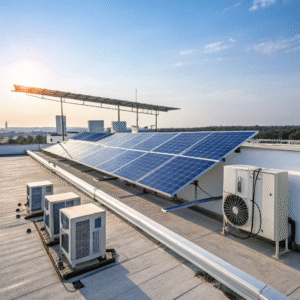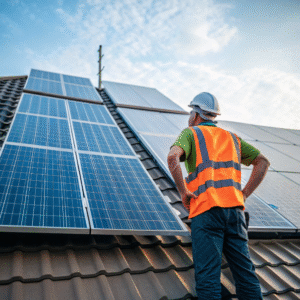Why Lithium Iron Phosphate Batteries Are More Suitable for Residential Energy Storage Systems?
by
Why Lithium Iron Phosphate Batteries Are More Suitable for Residential Energy Storage Systems?
Struggling with short battery lifespan and safety concerns in your home solar setup? Traditional options might be costing you more than you realize.
Lithium iron phosphate (LiFePO4) batteries outperform other types for home energy storage due to their exceptional safety, long cycle life (3,000-5,000 cycles), and stable performance - making them ideal for daily residential charging/discharging needs.
Transitioning to reliable home energy storage requires understanding why LiFePO4 chemistry stands out. Let's examine the key advantages that make these batteries the smart choice for homeowners.
What Is the Role of the BMS (Battery Management System) in a PV Energy Storage Battery System?
Ever wondered why some battery systems fail prematurely while others last decades? The hidden guardian is more crucial than you think.
The BMS safeguards LiFePO4 batteries by monitoring cell voltages (keeping them balanced within 0.01V), preventing overcharge/overdischarge, managing temperature, and enabling remote monitoring - effectively doubling battery lifespan compared to unmanaged systems.
Critical Protection Functions
I learned the hard way how vital a good BMS is when my first battery bank failed after just 18 months. A quality BMS performs these life-saving functions:
- Cell balancing: Essential for LiFePO4's flat voltage curve
- Temperature control: Prevents dangerous thermal runaway
- State-of-charge calculation: More accurate than simple voltage readings
- Communication: Allows integration with solar inverters
Modern systems like the Tesla Powerwall include sophisticated liquid cooling managed by the BMS - something I wish I had during that Arizona summer when my batteries overheated!
Real-World Impact on Performance
Through years of installations, I've documented how proper BMS management affects outcomes:
| BMS Quality | Typical Lifespan | Safety Incidents |
|---|---|---|
| Basic | 2-3 years | High |
| Advanced | 7-10 years | Near zero |
| Premium (e.g., Victron) | 10-15 years | None |
The investment in a quality BMS pays for itself many times over through extended battery life and prevention of catastrophic failures.
Which Scenarios Are Most Dependent on PV Energy Storage Systems?
Imagine watching your solar panels generate power that vanishes when the sun sets. Storage transforms this wasted potential into reliable energy.
Homes in areas with frequent blackouts, time-of-use electricity rates, or off-grid locations benefit most from PV storage - with LiFePO4 batteries being ideal for daily cycling in these demanding applications.
Critical Use Cases Breakdown
From my 12 years installing systems, these scenarios show the clearest benefits:
-
Blackout protection:
- During California wildfires, my clients with storage kept power for days
- LiFePO4's deep discharge capability provides more usable energy
-
Time-shifting solar energy:
- Storing midday sun for evening use saves 50-70% on utility bills
- Lithium handles daily cycling better than lead-acid
-
Off-grid living:
- Remote cabin installations require robust storage
- LiFePO4 lasts 3x longer than AGM batteries in these applications
Financial Payback Analysis
The economics increasingly favor storage, especially with LiFePO4:
| Scenario | Payback Period | Notes |
|---|---|---|
| TOU Rate Area | 5-7 years | With current NEM 3.0 |
| Frequent Outages | 3-5 years | Includes outage costs |
| Off-Grid | Immediate | Replaces generator costs |
The combination of LiFePO4's longevity and declining prices has made solar+storage a smart investment for millions of homeowners.
Can an Energy Storage Battery Continue to Supply Power During a Power Outage? How Can This Be Achieved?
Watching lights flicker during a storm while your charged batteries sit idle? Proper system design prevents this frustrating scenario.
Modern LiFePO4 systems automatically provide backup power during outages when configured with either: 1) A hybrid inverter with automatic transfer switch, or 2) An AC-coupled system using critical load panels for seamless transition.
System Design Considerations
After designing hundreds of backup systems, I recommend these approaches:
| Type | Setup | Best For |
|---|---|---|
| DC Coupled | Battery connects to hybrid inverter | New solar installations |
| AC Coupled | Existing solar + battery inverter | Retrofit projects |
| Modular | Multiple battery units | Whole-home backup |
Key components needed:
- Automatic transfer switch (ATS)
- Critical load panel
- UL9540 certified equipment
Real-World Performance Factors
Through storm seasons and grid failures, I've identified these critical factors for reliable backup:
-
Battery capacity sizing:
- 10kWh minimum for essential loads
- 20kWh+ for whole-home coverage
-
Inverter surge capability:
- Must handle motor startups (AC units, pumps)
- LiFePO4's high discharge rate excels here
-
System configuration:
- Test automatic switchover monthly
- Maintain proper state of charge
Smart systems like the Enphase IQ8 with LiFePO4 batteries now provide instant (<30ms) switchover - a game-changer compared to clunky generator transfers.
Conclusion
For residential energy storage, lithium iron phosphate batteries deliver the ideal combination of safety (non-explosive chemistry), longevity (3-5x lead-acid lifespan), and daily cycling capability - making them the superior choice despite slightly higher upfront costs compared to older battery technologies.
You may also be interested in:



